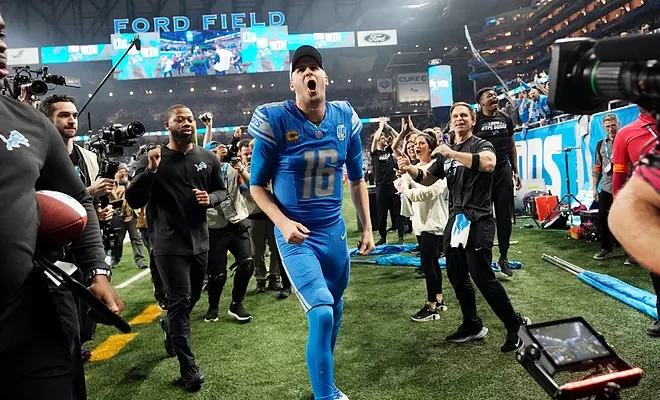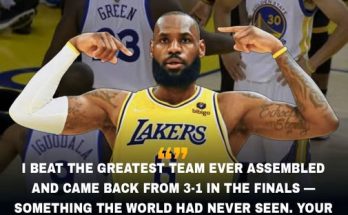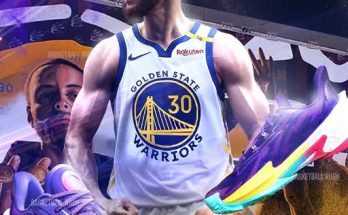Jared Goff’s tenure with the Detroit Lions has entered a critical juncture, and the challenges he faces this season carry more than just the weight of expectations—they carry a very real risk to his physical durability. The NFL is a league built on the collision of athleticism, strategy, and endurance, and quarterbacks, despite their protective gear, are continually exposed to the full brunt of it. History has shown that even elite talents like Patrick Mahomes are not immune to the wear and tear that comes with a grueling NFL schedule, and now, with Jared Goff under the spotlight in Detroit, there is growing concern that the Lions’ star quarterback could face a similar test. Goff, who has long been recognized for his composure and ability to manage a game efficiently, now must navigate a combination of offensive pressure, defensive scrutiny, and physical punishment that could challenge his long-term viability in the league.
In Detroit, Goff has become the centerpiece of a franchise striving for relevance in a highly competitive NFC North. The Lions have invested significantly in both offensive and defensive talent, creating an environment where the quarterback’s performance is not only a measure of his individual skill but also a reflection of the team’s overall success. Yet, the same investment that elevates expectations also increases exposure. Detroit’s offensive line, while improved over recent seasons, is not impervious to elite pass rushers, and Goff, like Mahomes before him, faces a schedule that pits him against some of the most aggressive defensive units in the NFL. The grind of weekly preparation, combined with the physical toll of high-velocity hits, can accelerate fatigue and heighten the risk of injury, particularly for quarterbacks who are relied upon to execute both short and deep passing schemes under duress.
Goff’s playing style is particularly relevant in this discussion. Unlike quarterbacks who primarily rely on mobility to evade pressure, Goff often extends plays within the pocket, relying on his vision, timing, and accuracy to dissect defenses. This approach has made him successful, but it also increases the number of hits he absorbs during a game. Every second spent scanning for an open receiver under the weight of incoming pass rushers is a second of exposure to potential injury. Mahomes, despite his extraordinary athleticism and improvisational ability, faced similar challenges before suffering a mid-season ankle injury that nearly sidelined him for the remainder of the year. The parallels are clear: elite quarterbacks who extend plays and carry a heavy offensive load are inherently at risk of wear and tear, and Goff’s role in Detroit places him squarely in that category.
Moreover, the NFC North presents a unique set of challenges that can exacerbate physical strain. Teams like the Chicago Bears and Green Bay Packers are known for physical defenses that leverage size, strength, and speed to disrupt timing and create pressure. Detroit’s schedule ensures that Goff will face repeated encounters with formidable pass rushers, often in adverse weather conditions that make footing and balance unpredictable. Cold, wet, or slippery field conditions amplify the difficulty of maintaining pocket stability, forcing quarterbacks to adjust mechanics and take additional hits as they attempt to execute plays. Mahomes experienced similar adversities during his injury-plagued season, where both defensive aggression and environmental factors compounded the risks he faced on the field. For Goff, each game in the NFC North is not merely a test of skill but a test of endurance and resilience.
Detroit’s offensive strategy also plays a significant role in evaluating Goff’s wear and tear risk. Head coach Dan Campbell has emphasized a balanced approach that mixes run-heavy formations with dynamic passing schemes. While the running game can alleviate some pressure on the quarterback by controlling the clock and keeping defenses honest, it also places Goff in positions where he must read complex defensive alignments and make rapid decisions. Quick-release passes, deep drops, and pre-snap adjustments all demand both mental focus and physical stamina. The cumulative effect of these demands over a 17-game schedule can be taxing, even for a seasoned veteran like Goff. The scenario echoes Mahomes’ situation, where the combination of offensive responsibility and physical exposure contributed to the strain on his ankle and overall performance.
Injury history and durability trends are crucial in this context. While Jared Goff has demonstrated a relatively durable career to date, the subtle effects of repeated contact are often invisible until they manifest as performance decline or injury. Quarterbacks may experience cumulative microtraumas—small, repeated impacts that, over time, degrade mobility, arm strength, and pocket confidence. Mahomes’ near-season-ending injury highlighted how quickly such stressors can disrupt even the most talented quarterback’s season. For Detroit, safeguarding Goff involves not only strategic game planning but also meticulous attention to practice regimens, recovery protocols, and in-game management. The Lions’ coaching staff must weigh the benefits of aggressive offensive schemes against the potential cost to Goff’s long-term health.
Goff’s mental resilience is another factor worth examining. Handling the psychological burden of being the franchise quarterback, especially in a city like Detroit where expectations are high, can amplify physical stress. Quarterbacks under constant pressure to perform often exhibit altered mechanics, quicker decision-making under duress, or tendencies to absorb hits rather than evade them. This phenomenon is not uncommon; Mahomes himself reported the mental strain of balancing playmaking with self-preservation during his injury season. For Goff, maintaining a balance between aggression and caution is essential to surviving the season without succumbing to significant wear and tear.
Additionally, Detroit’s supporting cast will directly influence Goff’s exposure to risk. Wide receivers capable of gaining yards after the catch, tight ends adept at securing contested passes, and running backs who effectively pass block can reduce the quarterback’s time in the pocket and limit hits taken. Conversely, if skill-position players fail to separate or if protection schemes falter, Goff is forced to extend plays, increasing the likelihood of physical strain. The Lions’ offensive line continuity and depth are therefore pivotal, as even minor lapses in protection can translate into significant quarterback hits over the course of a season. Mahomes experienced similar vulnerabilities when his offensive line was stretched thin, underscoring the importance of holistic team dynamics in quarterback durability.
Injuries to quarterbacks are not merely physical setbacks; they can have cascading effects on team performance. A sidelined quarterback alters game planning, affects team morale, and forces adjustments that ripple across offensive and defensive units. Detroit’s aspirations for playoff contention hinge on Goff’s ability to remain healthy and perform at a high level. Any prolonged absence, whether due to wear and tear or a specific injury, could derail the Lions’ trajectory. The Mahomes precedent is instructive: Kansas City’s offensive rhythm and championship ambitions were severely disrupted during his recovery period, illustrating the profound influence of quarterback health on overall team success.
Preventative measures, recovery protocols, and technological interventions are part of the modern quarterback’s toolkit. Load management, specialized training regimens, and monitoring of biomechanical stress are increasingly employed to mitigate wear and tear. Goff and the Lions are likely to leverage these strategies, aiming to extend his effectiveness over the full season. However, no protocol can completely eliminate the inherent risks posed by defensive pressure, repeated collisions, and the demands of high-stakes competition. The season-long grind is a crucible that tests both physical endurance and mental fortitude, and Goff’s ability to navigate it will define not only his personal trajectory but also Detroit’s playoff ambitions.
Ultimately, Jared Goff’s situation in Detroit highlights a broader truth about quarterbacking in the NFL: even the most talented and seemingly durable players are vulnerable to the cumulative effects of high-intensity competition. The comparisons to Patrick Mahomes’ injury challenges serve as a cautionary tale, illustrating how wear and tear can emerge subtly yet dramatically alter a season. For Goff, the task is not only to execute plays with precision but also to preserve his body and mental acuity across a demanding schedule. Detroit’s strategy must balance offensive ambition with quarterback protection, ensuring that Goff’s skill set is maximized while minimizing unnecessary exposure.
As the Lions move deeper into the season, the intersection of offensive responsibility, defensive pressure, environmental conditions, and physical resilience will dictate how effectively Goff can navigate the challenges ahead. History, particularly the example set by Mahomes, underscores the thin line between a productive, full season and one curtailed by injury. Jared Goff’s ability to manage this delicate balance will be pivotal not only for his career but also for Detroit’s aspirations of ascending in the NFC North and making a meaningful postseason run. Each game presents both opportunity and risk, and Goff’s longevity in the league will be defined by how adeptly he handles the wear and tear that has historically tested even the most elite quarterbacks. The Lions, the fans, and the broader NFL will be watching closely as Goff confronts the dual challenge of performance and preservation, a challenge that may well define the next chapter of his professional journey.
The season ahead promises to be a proving ground for Jared Goff. The physical demands, the mental pressure, and the relentless scrutiny of professional football converge in ways that test every facet of a quarterback’s preparation and resilience. Detroit has invested in both talent and strategy to maximize Goff’s effectiveness, yet the shadow of wear and tear looms as a persistent concern. Patrick Mahomes’ near-season-ending injury stands as a stark reminder that no quarterback, regardless of skill or conditioning, is immune to the physical realities of the NFL. For Jared Goff, each dropback, each extended play, and each collision represents not just an immediate challenge but a cumulative test of endurance. How he navigates this landscape will have lasting implications, defining both his career trajectory and the fortunes of the Detroit Lions for years to come.
The stakes are high, and the margin for error is thin. Goff’s performance, health, and decision-making will be scrutinized at every turn, not only by coaches and analysts but by a fan base hungry for success and hungry for proof that their franchise quarterback can withstand the rigors of elite competition. If history serves as a guide, the challenges he faces are formidable, and the wear and tear he is likely to encounter in Detroit could rival that which threatened to derail Patrick Mahomes’ season. Yet, with strategic preparation, robust support, and personal resilience, Goff has the opportunity to navigate these challenges successfully, proving that he can endure the physical demands of the league while elevating the Lions into serious contention. The journey will be arduous, but it is precisely in confronting such adversity that elite quarterbacks are defined, and Jared Goff’s response will undoubtedly shape the narrative of Detroit football for the foreseeable future.
The Lions’ coaching staff, medical team, and Goff himself must remain vigilant, understanding that the balance between aggressive performance and careful preservation is delicate. Each practice, each in-game adjustment, and each recovery session carries weight, influencing not only Goff’s immediate output but also his long-term career sustainability. The echoes of Mahomes’ struggles are clear: elite quarterbacks who push the limits of their physical and mental capacities are inherently at risk, and the lessons from prior seasons should guide the Lions in safeguarding their franchise cornerstone. As the season unfolds, every snap will be both a test of skill and a measure of endurance, underscoring the inescapable reality that wear and tear is as much a part of NFL quarterbacking as preparation, strategy, and talent.
Ultimately, Jared Goff’s experience in Detroit may serve as a case study in quarterback durability, workload management, and the intersection of physical resilience and professional expectation. His performance, health, and ability to navigate the challenges ahead will not only define his legacy but also shape the Detroit Lions’ trajectory in a fiercely competitive NFC. As the parallels to Patrick Mahomes’ near-miss injury illustrate, the line between peak performance and physical setback is thin and often unpredictable. How Goff manages this reality will be a defining storyline of the season, providing both a cautionary tale and a potential blueprint for sustaining elite quarterback play amidst the relentless demands of the NFL.
Jared Goff’s journey with the Detroit Lions, therefore, is not merely about wins and losses—it is about endurance, resilience, and the capacity to thrive under conditions that have historically tested even the league’s most gifted quarterbacks. The coming months will reveal whether Goff can withstand the wear and tear that the NFL inevitably imposes, navigating the fine balance between risk and reward, and ultimately whether he can lead Detroit to both immediate success and long-term stability. In an era where quarterback durability is constantly under scrutiny, Goff’s performance this season may very well become a benchmark for understanding how talent, preparation, and resilience converge in one of the most demanding roles in professional sports.
The season ahead will be a defining chapter in Jared Goff’s career, as he confronts the same pressures and physical risks that have challenged quarterbacks like Patrick Mahomes. The Detroit Lions have invested heavily in both talent and strategy to support him, yet the relentless grind of an NFL season, coupled with the physical demands inherent in the position, ensures that every snap carries consequence. Goff’s ability to endure, adapt, and excel under these conditions will not only shape his personal legacy but also determine the trajectory of a Detroit Lions franchise striving for relevance and postseason success. The narrative of wear and tear, once exemplified by Mahomes, now unfolds anew in Detroit, with Jared Goff at the center of a test that blends skill, resilience, and the unforgiving reality of professional football.



